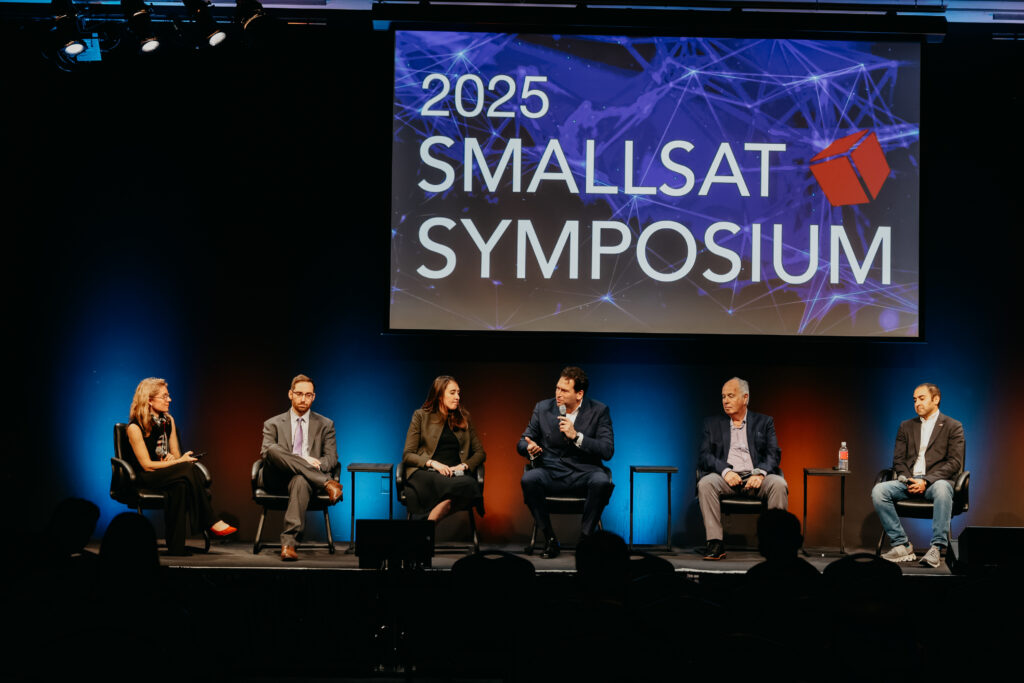By Chris Forrester

Moderator Lori Gordon, Space Enterprise Integration Corp Chief Engineer’s Office, The Aerospace Corp. posed a question to her panel at the Smallsat Symposium in Mountain View, and concerned data and the benefits – and risks of commoditization in general.
Alexander Greenberg, Co-founder/CEO, Loft Orbital said there’s a problem. “We on the commercial side can take advantage of military spend and these commercial companies can benefit from commoditization. We all have to remember that standards tend not to happen in the space industry. Some scientific instruments are far from ‘plug and play’. This is OK, but the device has to address the complexity around it.”
Brooke Stokes, Partner, McKinsey & Co. told delegates that commoditization is happening but if you look at NASA’s spend over the past 10 years then the amount of spend allocated to commercial operators has more than doubled while at the same time the overall spend has also grown. For the DoD it has tripled. But the second data point is that the spend on satellite manufacturing by the U.S. government and some 97% of that spend is on what we call ‘exquisites’ and over the past 5 years this has dropped to two-thirds.
“As to D2D operators there might be more who will try but direct-to-device has a fair number of hurdles which we all recognise. The partnerships already announced seem to be the way to go,” added Stokes.
“I’d also suggest you looked closely at where Government cash is going, and watch for the inflection point. On the private side of investment there’s a real ‘valley of death’ risk and the worry about the cash either running out or a business successfully assembling a ‘C’ round of cash raising.”
Alvaro Sanchez, President, Integrasys, added that the overall spend on space and satellite is growing exponentially and many new business models are emerging. “Look at data transfer. It is not that long ago that 4 Mb/s up to a satellite was enough. Now, its 40 Mb/s and rising. The costs – per Meg – have reduced by a few measures of magnitude. I was in Australia a few weeks ago, and in a store the salesman started selling me a Starlink system with enthusiasm. He was right, but it is now a simple retail commodity. Data is already largely a commodity but these falling costs will allow many others to enter the market with new products, and hopefully succeed. Competition is healthy, and once a problem is identified then a solution will hopefully emerge. We need to keep this innovation moving. There’s a trend with LEO, and a shift to services. If something has been commoditised then why would you want to invent something new unless it really is a better service?”
“As to D2D I think there will be around 4. Perhaps eventually there could be just 2 or 3 with M&A,” said Sanchez.
Renato Dias, CEO, United Teleports said that standards had to be followed. “Look at the difference between SpaceX and Boeing for standardisation of an astronaut’s space suit. There is always the question of commoditisation vs innovation. From Starlink has come Starshield.”
Dr. Behzad Koosha, BD Lead for Space Architecture Development, Sidus Space, stated that market trends are changing and rapidly. “Optical is very important, and launch costs have tumbled and enabled customers to get to orbit. Having the best satellites is one step and they need equally sophisticated ground services behind them. ESA has an excellent small business programme, and are addressing the supply side.”
